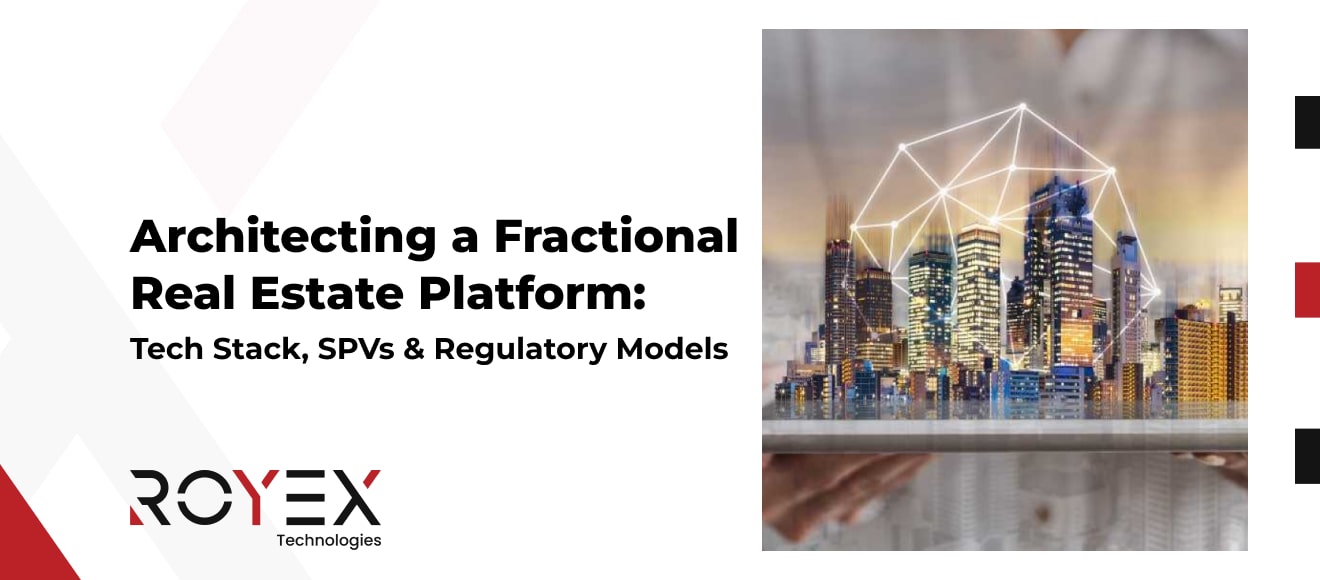
Architecting a Fractional Real Estate Platform: Tech Stack, SPVs & Regulatory Models
Introduction: The Convergence of Real Estate and Fintech
Real estate has always been a cornerstone of wealth creation. It’s a tangible, appreciating asset class that generates consistent income and offers long-term stability. Yet, for much of history, property investment has been the domain of the wealthy — high entry costs, illiquidity, and geographic restrictions kept the average investor out.
In recent years, fractional real estate platforms have emerged to break these barriers. By leveraging modern fintech infrastructure, blockchain technology, and structured legal frameworks, these platforms allow investors to own small, income-generating shares of real estate — without the complexities of direct ownership.
Two standout models in the UAE are:
-
PRYPCO — operating under the Virtual Assets Regulatory Authority (VARA), issuing Dubai Land Department (DLD) Token Ownership Certificates, and using blockchain tokenization.
-
GetStake (Stake) — operating via Special Purpose Vehicles (SPVs) registered in the Dubai International Financial Centre (DIFC), regulated by the Dubai Financial Services Authority (DFSA) and Saudi Arabia’s Capital Market Authority (CMA).
While both make property investment accessible and efficient, they differ significantly in their technical architecture and legal structure. This article will unpack both models, detailing smart contracts, blockchain integration, investor compliance workflows, and resale mechanisms, so you can architect a compliant, scalable fractional property platform.
2. Understanding Fractional Real Estate Platforms
Fractional real estate platforms allow investors to purchase a fraction of an asset, usually via:
-
SPV-based equity structures (e.g., GetStake)
-
Blockchain tokenization models (e.g., PRYPCO)
2.1 The Core Objectives
-
Lower the minimum investment threshold (AED 500–AED 2,000 in the UAE)
-
Provide passive income from rental yields
-
Enable capital appreciation participation
-
Reduce operational burdens via platform-managed ownership
3. Legal Frameworks: SPVs vs Tokenization
3.1 PRYPCO’s Tokenization Model
PRYPCO divides property ownership into digital tokens ("Blocks") on the XRP Ledger, each representing a legally recognized share of ownership. The DLD Token Ownership Certificate serves as government-backed proof.
Regulatory Touchpoints:
-
VARA — Governs virtual asset issuance and exchange
-
DLD — Verifies property details and issues certificates
-
Central Bank of UAE — Oversees Client Money Accounts (CMAs) for fund custody
Advantages:
-
Near-instant trading potential
-
Global investor participation
-
Lower per-property legal overhead after framework setup
Challenges:
-
Investor education on blockchain wallets
-
Evolving token regulations
3.2 GetStake’s SPV Model
Each property is owned by a Special Purpose Vehicle (SPV) — usually a DIFC-registered company. Investors purchase equity shares in the SPV, which holds the property’s title deed.
Regulatory Touchpoints:
-
DFSA — Licenses crowdfunding and investment activities
-
DIFC Registrar — Governs SPV formation and compliance
-
CMA (KSA expansion) — Supervises operations in Saudi Arabia
Advantages:
-
Familiar legal structure for traditional investors
-
Strong corporate law protections
-
No blockchain onboarding barrier
Challenges:
-
Limited liquidity (exit windows every 6–12 months)
-
Higher legal cost per property
4. Technical Architecture: Core Components
To architect a fractional real estate platform, whether SPV or tokenized, you’ll need a multi-layered tech stack:
4.1 Frontend Layer
-
Web Application — React.js, Next.js, or Vue.js
-
Mobile App — React Native or Flutter for cross-platform deployment
-
UI/UX Considerations — Investor dashboards, property details pages, ROI calculators
4.2 Backend Layer
-
Application Server — Node.js (NestJS for structure) or Laravel
-
Database — PostgreSQL for relational data; Redis for caching
-
APIs — REST/GraphQL for modular integration
-
Microservices — For payments, compliance, and marketplace modules
4.3 Blockchain Integration (Tokenization Model)
For PRYPCO-style platforms:
-
Blockchain Network — XRP Ledger (PRYPCO), Ethereum, or Polygon
-
Smart Contracts — Written in Solidity (Ethereum/Polygon) or XRPL scripts
-
Token Standards — ERC-1400 (security tokens), ERC-20/721 hybrids for property-linked assets
-
Wallet Integration — MetaMask, WalletConnect, or embedded custodial wallets
-
Transaction Logging — On-chain + off-chain synchronization
4.4 SPV & Document Management (SPV Model)
For GetStake-style platforms:
-
SPV Creation Automation — Integration with DIFC Registrar APIs (if available)
-
Equity Management — Shareholder registry with digital certificates
-
Document Storage — Secure storage of title deeds, valuation reports, SPV constitutions
-
E-Signing — DocuSign, Adobe Sign integrations
4.5 Compliance Engine
-
KYC/AML Providers — Sumsub, Shufti Pro, Onfido
-
Investor Suitability — Risk assessment questionnaires
-
Transaction Monitoring — Screening for unusual activity
-
Sanctions Lists — Global watchlist integrations
4.6 Payment & Payout Systems
-
Incoming Payments — Stripe, Checkout.com, PayTabs for fiat; crypto gateways for tokenized models
-
Escrow/CMA Handling — Fund segregation until property acquisition closes
-
Payouts — Monthly rental distributions, either via bank transfer or stablecoins
4.7 Marketplace & Resale Mechanisms
-
SPV Model — Time-bound “exit windows” where investors can list shares for resale; platform matches buyers and sellers.
-
Tokenization Model — Continuous secondary market, potentially integrated with decentralized exchanges (DEXs) or in-platform order books.
5. Smart Contracts in Tokenized Real Estate
Smart contracts are self-executing code that enforce terms without intermediaries. In PRYPCO-style systems, they handle:
-
Token Minting & Burning — When new property blocks are sold or redeemed
-
Ownership Transfers — Enforcing legal checks before tokens move
-
Income Distribution — Automated rent payments proportional to holdings
-
Voting & Governance — For collective sale decisions
Security Best Practices:
-
Formal verification of code
-
Independent smart contract audits
-
Multi-signature admin controls
6. Investor Compliance: Onboarding to Ongoing Monitoring
6.1 Onboarding Workflow
-
Registration
-
KYC Verification
-
Risk Profiling
-
Funding Account Setup
-
Investor Agreement E-Signature
6.2 Ongoing Compliance
-
Periodic KYC refresh (e.g., annually)
-
AML transaction monitoring
-
FATCA/CRS reporting for cross-border investors
-
Regulatory filings to DFSA/VARA/DLD
7. Resale & Liquidity Models
7.1 SPV Exit Windows
-
Fixed intervals (e.g., twice yearly)
-
Valuation updates before window
-
Platform-mediated share transfers
7.2 Tokenized Secondary Markets
-
24/7 liquidity potential
-
Smart contracts settle trades instantly
-
Requires careful jurisdictional compliance to avoid unlicensed exchange operation
8. Case Studies: PRYPCO vs GetStake
8.1 PRYPCO Snapshot
-
Regulator: VARA
-
Ownership Proof: DLD Token Ownership Certificate
-
Blockchain: XRP Ledger
-
Min Investment: AED 2,000
-
Liquidity: Planned in-platform secondary market
8.2 GetStake Snapshot
-
Regulator: DFSA (UAE), CMA (KSA)
-
Ownership Proof: SPV share certificate + title deed
-
Tech: Traditional web + document management
-
Min Investment: AED 500
-
Liquidity: Biannual exit windows
9. Cost & Timeline for Development
Tokenization MVP — $80K–$120K, 6–9 months
SPV MVP — $70K–$100K, 5–8 months
Cost factors:
-
Compliance complexity
-
Marketplace functionality
-
Payment integrations
-
Blockchain development (tokenization model)
10. Monetization Strategies
10.1 SPV Model
-
Acquisition fees
-
Annual management fees
-
Exit/transfer fees
10.2 Tokenization Model
-
Token issuance fees
-
Trading commissions
-
Premium property listings
11. Scaling & Future Trends
-
Integration with DeFi lending — use tokens or SPV shares as collateral
-
AI-powered property selection & valuation
-
Global investor onboarding via regulatory passporting
-
Expansion into commercial and hospitality sectors
12. Why Royex Technologies is the Ideal Partner
-
Regulatory Experience — DFSA, VARA, CMA compliance projects
-
Blockchain Expertise — Smart contract and token platform builds
-
End-to-End Delivery — From UX design to legal liaison
-
Modular Builds — Ready for future expansion
-
Proven Track Record — 500+ enterprise-grade projects
13. Conclusion
Architecting a fractional real estate platform requires more than just code — it demands a fusion of legal structuring, regulatory compliance, and robust technology. Whether you choose an SPV-based or tokenized model, success depends on integrating these elements seamlessly.
With platforms like PRYPCO and GetStake proving the demand, there’s never been a better time to launch. Royex Technologies can guide you from concept to launch, ensuring your platform is compliant, scalable, and investor-ready.
📩 Contact Royex today to start your fractional real estate platform journey.





